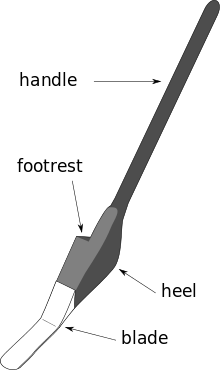Loy (spade)

Aloyis an earlyIrishspadewith a long heavy handle made ofash,a narrow steel plate on the face and a single footrest. The word loy comes from theIrishwordláí(Old Irishláige,Proto-Celtic*laginā), which means "spade".[1]It was used for manualploughingprior to and during theGreat Famine.[2][3]
Construction
[edit]The loy is a narrow spade with a blade about 35 cm (14 inches) long by 7.5 cm (3 inches) wide and bent with a handle 1.5 to 1.8 m (5 to 6 feet) long.[4]The handle is normally made ofash.The blade has a single step for use with the right or left[5]foot.[6]
Ridging using the loy
[edit]The loy was traditionally used forcultivatingthepotato.In the 19th century, these were grown in a potato ridge, sometimes known as alazy bed.Sods were turned from either side to form the ridge. This was sometimes called copin the sods, and the sods forming the sides of the ridge were called cope sods. A sod of earth about 2 feet (60 cm) wide on each side of the intended ridge was lifted by the loy and turned over so that the grassy sides were together.Manurewas spread on the ridge part first.[7]Narrow ridges were most often made with sets of around twelve sods.[2]Loy ploughing took place on very small farms or on very hilly ground, where horses could not work or where farmers could not afford them[2]and were used up until the 1960s in poorer land.[8]This suited the moist climate of Ireland as the trenches formed by turning in the sods provided drainage. It also allowed the growing of potatoes in bogs as well as on mountain slopes where no other cultivation could take place.[9]
Other uses
[edit]As well as ploughing and ridgemaking, the loy was also used for lifting potatoes and diggingturf.[10]Loy digging is still a popular pastime in Ireland with a national Loy Digging Association. Loy digging is an integral part of theNational Ploughing Championships.[11][12]
The loy in culture
[edit]Theatre
[edit]The Playboy of the Western Worldby Irish playwrightJohn Millington Synge,set in a public house inCounty Mayoduring the early 1900s, tells the story of Christy Mahon, a young man running away from his farm. Mahon claims he killed his father by driving a loy into his head.[13]
Literature
[edit]Irish writerDeclan Hughes' novels center around thedetectiveEd Loy, whose name is a homage toSam Spade,the fictional character ofDashiell Hammett'sThe Maltese Falcon.[14]
References
[edit]- ^"eDIL - Irish Language Dictionary".www.dil.ie.
- ^abcPaul Hughes (3 March 2011)."Castlepollard venue to host Westmeath ploughing finals".Westmeath Examiner.Archived fromthe originalon 2 October 2011.Retrieved1 June2011.
- ^Paul Hughes (30 September 2008)."Collinstown man scoops national ploughing prize".Westmeath Examiner.Archived fromthe originalon 2 October 2011.Retrieved1 June2011.
- ^"LEITRIM AGRICULTURE".Retrieved1 June2011.
- ^SPUD Strokestown - YouTube– viaYouTube.
- ^"Digging with the right foot".Gorey Echo. 3 February 2011. Archived fromthe originalon 23 July 2011.Retrieved1 June2011.
- ^"Ulster-Scots".BBC.Retrieved1 June2011.
- ^Patrick Freyne (27 September 2009)."The plough and the stars".Sunday Tribune.Dublin. Archived fromthe originalon 31 March 2012.Retrieved1 June2011.
- ^"The Famine Potato".St Mary's Famine History Museum. Archived fromthe originalon 24 May 2011.Retrieved1 June2011.
- ^"County Longford Ploughing Championships, 10th April 2011".Longford Library.Retrieved1 June2011.
- ^"Leitrim Ploughing Championship 2010".Leitrim Oserver. 25 March 2010. Archived fromthe originalon 20 July 2011.Retrieved1 June2011.
- ^Aine Ryan (8 May 2008)."Turf tales".The Mayo News. Archived fromthe originalon 5 March 2012.Retrieved1 June2011.
- ^"The Playboy of the Western World".DruidSynge, The Plays of John Millington Synge. Archived fromthe originalon 20 July 2011.Retrieved2 June2011.
- ^Jack Batten (4 November 2009)."An Irish Sam Spade suffers a mite much".thestar.com.Retrieved1 June2011.
Further reading
[edit]- Bell, Jonathan. "Wooden Ploughs From The Mountains Of Mourne, Ireland,"Tools & Tillage(1980) 4#1 pp 46–56.
- Watson, Mervyn. "Common Irish Plough Types And Tillage Techniques,"Tools & Tillage(1985) 5#2 pp 85–98.
